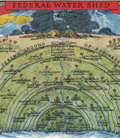| | Thumbnail | | Creator | Date | Title / Author / Date / Location | Price | | | Description |
| 6797 |  | Details | Appleton, LeRoy H. | 1935 |
| New Deal allegorical pictorial map Federal Water Shed |
|
Appleton, LeRoy H. |
|
| 1935 |
| LOC:89 |
| $225.00 | Appleton--LeRoy-H- | New-Deal-allegorical-pictorial-map-Federal-Water-Shed | A stunningly-executed allegorical persuasive map on the subject of the New Deal by LeRoy Appleton. The intent of the map was to argue against FDR's New Deal policies.
<br><br>
The New Deal was a series of economic programs and reforms implemented by President Franklin D. Roosevelt in the United States during the 1930s in response to the Great Depression. It aimed to provide relief, recovery, and reform to address the severe economic crisis and high unemployment rates of that time. It was implemented between 1933 and 1939.
<br><br>
Appleton uses water as a symbol to represent money, with rivers and wells as sources of that money later stored behind a dam, a symbol for the "reservoir of revenue."
<br><br>
Other allegorical imagery was used during that era to explain specific New Deal programs. For example, the symbol of the "Three Little Pigs" was employed to illustrate the different types of economic recovery measures. The first pig represented the ineffective, weak measures of the past, while the second pig symbolized temporary relief efforts. The third pig, who built his house with sturdy bricks, represented the New Deal programs that aimed to provide long-term economic stability and reform. By employing such storytelling devices, FDR and his administration aimed to create a sense of unity, hope, and support for the New Deal programs among the American people. Found in an issue of Fortune Magazine in 1935.<br> |